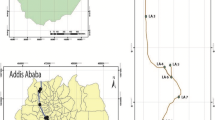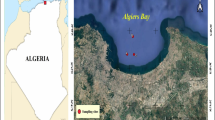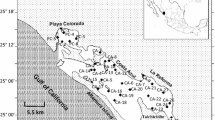Abstract
Sediment samples were collected from a dry wash in Nelson, Nevada where the Techatticup Mine and Mill operated between 1850 and 1960. Samples were used to evaluate movement and behavior of certain metals and metalloids including aluminum, arsenic, barium, cadmium, copper, iron, manganese, lead, and vanadium. The data show that some metals and metalloids are more concentrated on larger particles whereas others show the opposite tendency. For example, As was greatest on silt fractions and least on coarse fractions, while Se was detected only on silts. Chromium, Cu, Fe, Mn, Pb, and Zn concentrations all increased with decreasing particle size (silt > sand > coarse), whereas Al, Ba, and V showed the opposite trend (silt < sands < coarse).
Zusammenfassung
Aus einem ausgetrockneten Flussbett in Nelson (Nevada) wurden Sedimentproben entnommen. In diesem Gebiet wurde zwischen 1850 und 1960 die Techatticup Grube betrieben. An den Proben wurden der Transport und das Verhalten von verschiedenen Metallen und Metalloiden, wie Aluminium, Arsen, Barium, Cadmium, Kupfer, Eisen, Mangan, Blei und Vanadium untersucht. Die Ergebnisse zeigen, dass einige Metalle und Metalloide an größeren Partikel akkumuliert sind, wohingegen andere einen entgegengesetzten Trend zeigen. Beispielsweise war As in der Schlufffraktion konzentriert und in der Kiesfraktion abgereichert. Selen wurde nur in der Schlufffraktion nachgewiesen. Die Konzentration von Cr, Cu, Fe, Mn, Pb, und Zn stieg mit abnehmender Korngröße (Schluff > Sand > Kies), wohingegen Al, Ba und V einen entgegengesetzten Trend zeigten (Schluff < Sand < Kies).
Resumen
Muestras de sedimentos fueron colectadas en un cauce seco en Nelson, Nevada donde las minas Techatticup y Mill operaron entre 1850 y 1960. Las muestras fueron usadas para evaluar el movimiento y el comportamiento de ciertos metales y metaloides incluyendo aluminio, arsénico, bario, cadmio, cobre, hierro, manganeso, plomo y vanadio. Los datos muestran que algunos metales y metaloides están más concentrados en las partículas más grandes mientras que otros muestran la tendencia opuesta. Por ejemplo, As fue el mayor en las fracciones de limo y menos en fracciones gruesas, mientras que Se fue detectado solo en limos. Las concentraciones de Cr, Cu, Fe, Mn, Pb y Zn se incrementaron a medida que decrecía el tamaño de partícula (limo > arenas > grueso) mientras que Al, Ba y V mostraron la tendencia opuesta (limo < arenas < grueso).
抽象的
沉积物样品取自美国内华达州纳尔逊(Nelson, Nevada)的沙漠沟壑,区域内已废弃Techatticup矿的生产运行时间为1850 ~ 1960年。样品用于分析铝、砷、钡、镉、铜、铁、锰、铅、钒等金属和类金属的迁移特征。研究数据显示,一些金属和类金属元素更易富集于大颗粒沉积,而另一些元素易富集于小颗粒沉积。例如,砷在粉粒沉积中最多而在粗粒沉积中最少,硒几乎只能在粉粒沉积中才有检出。铬、铜、铁、锰、铅和锌浓度都随沉积颗粒粒径减小而增加(粉粒 > 砂粒 > 粗粒),而铝、钡和钒浓度随沉积颗粒粒径减小而减小(粉粒 < 砂粒 < 粗粒).



Similar content being viewed by others
References
Anderson RE (1971) Thin-skinned distension in Tertiary rocks of southeastern Nevada. Geol Soc Am Bull 82:43–58
Anderson RE, Longwell CR, Armstrong RL, Marvin RF (1972) Significance of K-Ar ages of Tertiary rocks from the Lake Mead region, Nevada-Arizona. Geol Soc Am Bull 83(2):273–288
Bell JW, Smith EI (1980) Geologic map of the Henderson Quadrangle. Map No. 67, Nevada Bureau of Mines and Geology, Reno
Bowell RJ (1994) Sorption of arsenic by iron oxides and oxyhydroxides in soils. Appl Geochem 9(3):279–286
Bureau of Reclamation (BOR) (1995) Preliminary assessments—Henderson lead site, Clark County, Nevada. EPA ID No. NV5141190608, BOR Boulder City, NV, USA
Camm GS, Butcher AR, Pirrie D, Hughes PK, Glass HJ (2003) Secondary mineral phase associated with a historic arsenic calciner identified using automated scanning electron microscopy; a pilot study from Cornwall, UK. Miner Eng 16(11):1269–1277
Camm GS, Glass HJ, Bryce DW, Butcher AR (2004) Characterization of a mining-related arsenic-contaminated site, Cornwall, UK. J Geochem Explor 82(1–3):1–15
Chaffee MA, Berry KH (2006) Abundance and distribution of selected elements in soils, stream sediments, and selected forage plants from desert tortoise habitats in the Mojave and Colorado deserts, USA. J Arid Environ 67:35–87
Chopin EIB, Alloway BJ (2007) Trace element partitioning and soil particle characterization around mining and smelting areas at Tharsis, Ríotinto and Huelva, SW Spain. Sci Total Environ 373:488–500
Darvall P (1991) Normal faulting in the Eldorado Mountains, southeastern Nevada. Geol Soc Am Abstr 23(2):17
Dong D, Derry LA, Lion LW (2003) Pb scavenging from a freshwater lake by Mn oxides in heterogeneous surface coating materials. Water Res 37:1662–1666
Fei Q, Hongbing J, Qian L, Xinyue G, Lei T, Jinguo F (2014) Evaluation of trace elements and identification of pollution sources in particle size fractions of soil from iron ore areas along the Chao River. J Geochem Explor 138:33–49
Giuliano V, Pagnanelli F, Bornoroni L, Torob L, Abbruzzese C (2007) Toxic elements at a disused mine district: particle size distribution and total concentration in stream sediments and mine tailings. J Hazard Mater 148:409–418
Google Maps (2014) Terrain maps. http://maps.google.com/maps?hl=en&tab=wl
Greene JM (1975) Life in Nelson Township, Eldorado Canyon, and Boulder City, MA Thesis (unpubl). History Dept, Univ of Nevada, Las Vegas
Hansen SM (1962) The Geology of the Eldorado Mining District, Clark County, Nevada. PhD Diss. Geology Dept, Univ of Missouri, Columbia
Hoar K, Nowinski P, Hodge V, Cizdziel J (2011) Rock varnish: a passive forensic tool for monitoring recent air pollution and source identification. Nuclear Tech 175:1–9
Horowitz AJ, Elrick KA, Cook RB (1993) Effect of mining and related activities on the sediment trace element geochemistry of Lake Coeur D’Alene, Idaho, USA. Part 1: surface sediments. Hydrol Proc 7:403–423
Ingri J, Widerlund A, Suteerasak T, Bauer S, Elming S (2014) Changes in trace metal sedimentation during freshening of a coastal basin. Mar Chem 167:2–12
Johannesson KH, Tang J (2009) Conservative behavior of arsenic and other oxyanion-forming trace elements in an oxic graoundwater flow system. J Hydrol 378:13–28
Jones MJ, Butchins LJ, Charnock JM, Pattrick RAD, Small JS, Vaughan DJ, Wincott PL, Livens FR (2011) Reactions of radium and barium with the surface of carbonate minerals. Appl Gechem 26:1231–1238
Khalil A, Hanich L, Bannari A, Zouhri L, Pourret O, Hakkou R (2013) Assessment of soil contamination around an abandoned mine in a semi-arid environment using geochemistry and geostatistics: pre-work of geochemical process modeling with numerical models. J Geochem Explor 125:117–129
Kim CS, Wilson KM, Rytuba JJ (2011) Particle-size dependence on metal(loid) distributions in mine wastes: implications for water contamination and human exposure. Appl Geochem 26:484–495
Kruskal WH, Wallis WA (1952) Use of ranks in one-criterion variance analysis. J Am Stat Assoc 47:583–621
Larios R, Fernandex-Martinez R, Alvarez R, Rucandio I (2012) Arsenic pollution and fractionation in sediments and mine waste samples from different mine sites. Sci Total Environ 431:426–435
Levene H (1960) Robust tests for equality of variances. In: Olkin I (ed) Contributions to probability and statistics. Stanford Univ Press, Palo Alto, pp 278–292
Li YH (2000) A compendium of geochemistry. Princeton Univ Press, Princeton
Longwell CR, Pampeyan EH, Bowyer B, Roberts RJ (1965) Geology and minerals deposits of Clark County, Nevada. A. Carlisle, Reno
Manceau A, Combes JM (1988) Structure of Mn and Fe oxides and oxyhydroxides: a topological approach by EXAFS. Phys Chem Miner 15(3):283–295
Modis K, Vatalis KI (2014) Assessing the risk of soil pollution around an industrialized mining region using a geostatistical approach. Soil Sediment Contam 23:63–75
Moreno-Jim´enez E, Peˇnalosa E, Manzano JM, Carpena-Ruiz RO (2009) Heavy metals distribution in soils surrounding an abandonedmine in NW Madrid (Spain) and their transference to wild flora. J Hazard Mater 162:854–859
Morikawa SA (1993) The geology of the tuff of bridge Spring: Southern Nevada and Northwestern Arizona. MS thesis, Univ of Nevada, Las Vegas
National Weather Service (NWS) (2014) http://www.nws.noaa.gov/organization.php. Accessed 15 Jan 2014
Navarro-Hervás MC, Pérez-Sirvent C, Martínez-Sánchez MJ, García-Lorenzo ML, Molina J (2012) Weathering processes in waste materials from a mining area in a semiarid zone. Appl Geochem 27:1991–2000
Nowinski P (2009) Desert varnish as an indicator of modern-day air pollution in southern Nevada. PhD Diss (unpubl), Dept of Environmental Studies, Univ of Nevada, Las Vegas
Nowinski P, Hodge VF, Lindley K, Cizdziel JV (2010) Elemental analysis of desert varnish samples in the vicinity of coal-fired power plants and the Nevada test site using laser ablation ICP-MS. Open Chem Biomed J 3:151–166
Nowinski P, Hodge VF, Gerstenberger S (2012) Application of field portable X-ray fluorescence to the analysis of desert varnish samples in areas affected by coal-fired power plants. Environ Chem 9(4):379–388
Nowinski P, Hodge VF, Gerstenberger S, Cizdziel JV (2013) Analysis of mercury in rock varnish samples in areas impacted by coal-fired power plants. Environ Poll 179:132–137
Ordo˜nez C, se la Fuentea A, Díaz-Palma P (1915) Modeling the influence of benthic primary production on oxygentransport through the water–sediment interface. Ecol Model 311:1–10
Oyanedel-Craver VA, Smith JA (2006) Effect of quaternary ammonium cation loading and pH on heavy metal sorption to Ca bentonite and two organobentonites. J Hazard Mater B137:1102–1114
Rango T, Vengosh A, Dwyer G, Bianchini G (2013) Mobilization of arsenic and other naturally occurring contaminants in groundwater of the Main Ethiopian Rift aquifers. Water Res 47:5801–5818
Reheis MC (2006) 16-year record of dust deposition in southern Nevada and California, USA. J Arid Environ 67:487–520
Ross C (2008) Preserving the culture while closing the holes-abandoned mine reclamation in Nevada. Presented at 30th Annual National Assoc of Abandoned Mine Land Program Conf, Durango
Sadiq M (1997) Arsenic chemistry in soils: an overview of thermodynamic predictions and field observations. Water Air Soil Poll 93:117–136
Sánchez-Martínez MA, Marmolejo-Rodríguez AJ, Magallanes-Ordóñez VR, Sánchez-González A (2013) Vertical accumulation of potential toxic elements in a semiarid system that is influenced by an abandoned gold mine. Estuar Coast Shelf Sci 130:42–53
Schropp, SJ (1988) A guide to the interpretation of metal concentrations in estuarine sediment. For the Florida Department of Environmental Protection, p 74
Shapiro SS, Wilk MB (1965) An analysis of variance test for normality (complete samples). Biometrika 52(3 and 4):591–611
Sims DB (2010) Contamination mobilization from anthropogenic influences in the Techatticup wash, Nelson, NV (USA). Soil Sediment Contam 19(5):515–530
Sims DB (2011) Fate of Contaminants at an Abandoned Mining site in an Arid Environment. PhD thesis (unpubl), Kingston Univ, London
Sims DB, Hooda PS, Gillmore GK (2013) Sediment contamination along desert wash systems from historic mining sites in a hyperarid region of southern Nevada, USA. Soil Sediment Contam 22:737–752
Slowey AJ, Johnson SB, Newville M, Brown GE (2007) Speciation and colloid transport of arsenic from mine tailings. Appl Geochem 22(9):1884–1898
Sparks DL (2003) Environmental soil chemistry. Academic Press, San Diego
Taylor MP, Kesterton RGH (2002) Heavy metal contamination of an arid river environment: Gruben River, Namibia. Geomorphology 42:311–327
Thiagarajan N, Lee CA (2004) Trace-element evidence for the origin of desert varnish by direct aqueous atmospheric deposition. Earth Planet Sci Lett 224:131–141
Thornton Iain (1983) Applied environmental geochemistry. Academic Press, Waltham
USEPA (1997) SW-846, Test methods for evaluating solids and wastes—physical/chemical methods, US Environmental Protection Agency (CD), Washington
Vidal M, Santos MJ, Abrao T, Rodriguez J, Rigal A (2009) Modeling competitive metal sorption in mineral soil. Geoderma 149:189–198
Vinson DS, Mcintosh JC, Dwyer GS, Vengosh A (2011) Arsenic and 9other oxyanion-forming trace elements in an alluvial basin aquifer: evaluating sources and mobilization by isotopic tracers (Sr, B, S, O, H, Ra). Appl Geochem 26:1364–1376
Warren LA, Zimmerman AP (1994) The importance of surface area in metal sorption by oxides and organic matter in a heterogeneous natural sediment. Appl Geochem 9:245–254
Wayne DM, Diaz TA, Fairhurst RJ, Orndorff RL, Pete DV (2006) Direct major-and trace-element analyses of rock varnish by high resolution laser ablation inductively-coupled plasma mass spectrometry (LA-ICPMS). Appl Geochem 21:1410–1431
Yu J, Steinberger Y (2012) Spatiotemporal changes in abiotic properties, microbial CO2 evolution, and biomass in playa and crust-covered interdune soils in a sand-dune desert ecosystem. Eur J Soil Biol 50:7–14
Yu L, Guo-he H, Bai-yu Z, Shu-hai G (2006) Scavenging of Cd through Fe/Mn oxides within natural surface coatings. J Environ Sci 18(6):1199–1203
Acknowledgments
We thank Deborah Morales of the University of Nevada, Las Vegas Department of Geoscience and Todd Jesus Gadol-Tait of the University of Hawaii at Hilo for the collection and processing of samples. We also thank the reviewers whose time and expertise added great value to the overall paper.
Author information
Authors and Affiliations
Corresponding author
Electronic supplementary material
Below is the link to the electronic supplementary material.
Rights and permissions
About this article
Cite this article
Sims, D.B., Hudson, A.C., Keller, J.E. et al. Trace Element Scavenging in Dry Wash Surficial Sediments in an Arid Region of Southern Nevada, USA. Mine Water Environ 36, 124–132 (2017). https://doi.org/10.1007/s10230-015-0379-8
Received:
Accepted:
Published:
Issue Date:
DOI: https://doi.org/10.1007/s10230-015-0379-8




